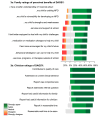An integrated clinical approach to children at genetic risk for neurodevelopmental and psychiatric conditions: interdisciplinary collaboration and research infrastructure
- PMID: 38970057
- PMCID: PMC11229023
- DOI: 10.1186/s11689-024-09552-x
An integrated clinical approach to children at genetic risk for neurodevelopmental and psychiatric conditions: interdisciplinary collaboration and research infrastructure
Abstract
Background: A sizeable proportion of pathogenic genetic variants identified in young children tested for congenital differences are associated with neurodevelopmental psychiatric disorders (NPD). In this growing group, a genetic diagnosis often precedes the emergence of diagnosable developmental concerns. Here, we describe DAGSY (Developmental Assessment of Genetically Susceptible Youth), a novel interdisciplinary 'genetic-diagnosis-first' clinic integrating psychiatric, psychological and genetic expertise, and report our first observations and feedback from families and referring clinicians.
Methods: We retrieved data on referral sources and indications, genetic and NPD diagnoses and recommendations for children seen at DAGSY between 2018 and 2022. Through a survey, we obtained feedback from twenty families and eleven referring clinicians.
Results: 159 children (mean age 10.2 years, 57.2% males) completed an interdisciplinary (psychiatry, psychology, genetic counselling) DAGSY assessment during this period. Of these, 69.8% had a pathogenic microdeletion or microduplication, 21.5% a sequence-level variant, 4.4% a chromosomal disorder, and 4.4% a variant of unknown significance with emerging evidence of pathogenicity. One in four children did not have a prior NPD diagnosis, and referral to DAGSY was motivated by their genetic vulnerability alone. Following assessment, 76.7% received at least one new NPD diagnosis, most frequently intellectual disability (24.5%), anxiety (20.7%), autism spectrum (18.9%) and specific learning (16.4%) disorder. Both families and clinicians responding to our survey expressed satisfaction, but also highlighted some areas for potential improvement.
Conclusions: DAGSY addresses an unmet clinical need for children identified with genetic variants that confer increased vulnerability for NPD and provides a crucial platform for research in this area. DAGSY can serve as a model for interdisciplinary clinics integrating child psychiatry, psychology and genetics, addressing both clinical and research needs for this emerging population.
Keywords: Genetic disorder; Genetics; Interdisciplinary clinic; Mental health; Neurodevelopmental disorder; Psychiatry; Psychology; Research framework.
© 2024. The Author(s).
Conflict of interest statement
J.V. has served as a consultant for NoBias Therapeutics Inc. and has received speaker fees for Henry Stewart Talks Ltd. S.W.S. is on the Scientific Advisory Committee of Population Bio, Deep Genomics, and serves as a Highly Cited Academic Advisor for King Abdulaziz University. Intellectual property from aspects of his research held at The Hospital for Sick Children are licensed to Athena Diagnostics and Population Bio. D.B. has received research funding from MapLight therapeutics. These relationships did not influence content of this manuscript but are disclosed for potential future considerations.
Figures



Similar articles
-
Risk of Psychiatric and Neurodevelopmental Disorders Among Siblings of Probands With Autism Spectrum Disorders.JAMA Psychiatry. 2016 Jun 1;73(6):622-9. doi: 10.1001/jamapsychiatry.2016.0495. JAMA Psychiatry. 2016. PMID: 27145529
-
Diagnostic genetic testing for neurodevelopmental psychiatric disorders: closing the gap between recommendation and clinical implementation.Curr Opin Genet Dev. 2021 Jun;68:1-8. doi: 10.1016/j.gde.2020.12.016. Epub 2021 Jan 9. Curr Opin Genet Dev. 2021. PMID: 33434711 Free PMC article. Review.
-
Support to caregivers who have received genetic information about neurodevelopmental and psychiatric vulnerability in their young children: A narrative review.Clin Genet. 2023 Aug;104(2):163-173. doi: 10.1111/cge.14349. Epub 2023 Apr 25. Clin Genet. 2023. PMID: 37098443 Review.
-
Right care, first time: a highly personalised and measurement-based care model to manage youth mental health.Med J Aust. 2019 Nov;211 Suppl 9:S3-S46. doi: 10.5694/mja2.50383. Med J Aust. 2019. PMID: 31679171
-
All for one and one for all: heterogeneity of genetic etiologies in neurodevelopmental psychiatric disorders.Curr Opin Genet Dev. 2021 Jun;68:71-78. doi: 10.1016/j.gde.2021.02.015. Epub 2021 Mar 25. Curr Opin Genet Dev. 2021. PMID: 33773394 Free PMC article. Review.
Cited by
-
Integrative genetic analysis: cornerstone of precision psychiatry.Mol Psychiatry. 2025 Jan;30(1):229-236. doi: 10.1038/s41380-024-02706-2. Epub 2024 Aug 30. Mol Psychiatry. 2025. PMID: 39215185 Review.
-
Systematic Review: The Psychosocial Impacts of Autism-Related Genetic Testing.J Am Acad Child Adolesc Psychiatry. 2025 Jul 3:S0890-8567(25)00328-4. doi: 10.1016/j.jaac.2025.06.024. Online ahead of print. J Am Acad Child Adolesc Psychiatry. 2025. PMID: 40619096 Free PMC article. Review.
-
Psychopharmacology in children with genetic disorders of epigenetic and chromatin regulation.J Neurodev Disord. 2025 Apr 24;17(1):21. doi: 10.1186/s11689-025-09605-9. J Neurodev Disord. 2025. PMID: 40275179 Free PMC article.
-
Early Intervention services in the era of genomic medicine: setting a research agenda.Pediatr Res. 2025 Mar;97(4):1320-1326. doi: 10.1038/s41390-024-03668-5. Epub 2024 Oct 22. Pediatr Res. 2025. PMID: 39438712 Free PMC article. Review.
-
International Precision Child Health Partnership (IPCHiP): an initiative to accelerate discovery and improve outcomes in rare pediatric disease.NPJ Genom Med. 2025 Feb 27;10(1):13. doi: 10.1038/s41525-025-00474-8. NPJ Genom Med. 2025. PMID: 40016282 Free PMC article. Review.
References
-
- Manickam K, McClain MR, Demmer LA, Biswas S, Kearney HM, Malinowski J, et al. Exome and genome sequencing for pediatric patients with congenital anomalies or intellectual disability: an evidence-based clinical guideline of the American College of Medical Genetics and Genomics (ACMG) Genet Med. 2021;23(11):2029–37. doi: 10.1038/s41436-021-01242-6. - DOI - PubMed
-
- Srivastava S, Love-Nichols JA, Dies KA, Ledbetter DH, Martin CL, Chung WK, et al. Meta-analysis and multidisciplinary consensus statement: exome sequencing is a first-tier clinical diagnostic test for individuals with neurodevelopmental disorders. Genet Med. 2019;21(11):2413–21. doi: 10.1038/s41436-019-0554-6. - DOI - PMC - PubMed
MeSH terms
LinkOut - more resources
Full Text Sources
Medical

